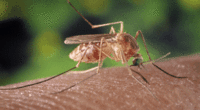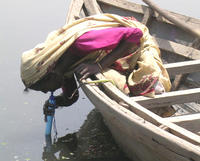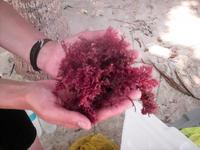-
Nano detector spots deadly anthrax
The average time of detection of an anthrax attack by current methods — the time required for DNA purification, combined with real-time polymerase chain reaction (PCR) analysis — is sixty minutes; a new, automatic, and portable detector takes just fifteen minutes to analyze a sample suspected of contamination with anthrax
-
-
New technology makes textiles permanently germ-free

University of Georgia scientist develops a new technology that makes textiles permanently germ-free, targeting healthcare-associated infections; the new material effectively kills a wide spectrum of bacteria, yeasts, and molds that can cause disease, break down fabrics, create stains, and produce odors
-
-
Biolabs: the solution may be the problem

Since the fall 2001 anthrax attacks, there has been a vast expansion of the U.S. bioterror research infrastructure; now, more than 11,000 scientists work on bioterrorism and agroterrorism research in seventeen major and many more smaller labs across the United States; billions of federal dollars are funding research on new vaccines and antibiotics to protect the population from anthrax, plague, tularemia, Ebola, and other lethal germs; what is the likelihood that there is another Bruce Ivins — perhaps more than one — among these thousands of researchers with access to the most lethal pathogens on Earth?
-
-
Promise of vaccine against deadly malaria parasite

Every year, 10,000 pregnant women and up to 200,000 newborn babies are killed by the malaria parasite; the body’s immune system normally attacks any foreign body, but since our spleen constantly filters our blood and removes ruined or deform blood cells, the body’s natural defense does not need to check the blood; the malaria parasite exploits this fact by using its advanced arsenal of protein hooks to attach itself to the inner side of the blood vessel; researchers find a soltuon
-
-
How safe is Kansas bio lab from twisters?

DHS officials say they are confident that the proposed bio-defense lab in Manhattan, Kansas, located in the heart of tornado alley, is capable of withstanding a direct hit from a powerful twister; engineers have hardened the $650 million National Bio and Agro-Defense Facility (NBAF) to withstand wind speeds of up to 230 miles per hour; but critics of the planned facility argue that the new standards are inadequate and that the facility must be further reinforced to ensure that in the event of a natural disaster the deadly pathogens and viruses stored there are not spread
-
-
Confusing mosquitoes to fight mosquito-borne disease

Female mosquitoes are efficient carriers of deadly diseases such as malaria, dengue and yellow fever, resulting each year in several million deaths and hundreds of millions of cases; to find human hosts to bite and spread disease, these mosquitoes use exhaled carbon dioxide as a vital cue; a disruption of the vital carbon dioxide detection machinery of mosquitoes, which would help control the spread of diseases they transmit, has been a long sought-after goal; University of California-Riverside scientists find a way to do just that
-
-
Decision on smallpox virus destruction delayed for three years
After a second round of negotiations Tuesday, the World Health Assembly (WHA) agreed to postpone setting a date for destruction of the world’s remaining smallpox virus stocks for another three years; the assembly simultaneously reaffirmed previous statements that the virus stocks should be destroyed after “crucial research” is completed; several countries, mainly developing ones, pushed for immediate destruction of the smallpox virus stocks, while others suggested a short delay for setting a deadline; U.S. officials had introduced a resolution to retain the virus stocks for at least another five years to allow work on bioterrorism countermeasures to continue; U.S. Secretary of Health and Human Services (HHS) Kathleen Sebelius said, however, that the United States was committed to the eventual destruction of the virus stocks
-
-
New device could help stop one of the world's deadliest killers

A new portable and low cost water sanitation device could help save millions of lives each year; water borne diseases contracted from contaminated water are one of the world’s leading causes of death; each year nearly two million people die, primarily young children, from preventable diseases like diarrhea, cholera, and typhoid from drinking unsafe water; it is estimated that roughly 1.1 billion people lack access to clean water, but all that could potentially change thanks to Torben Frandsen’s LifeStraw; LifeStraw is a 10 inch long straw that is capable of generating 185 gallons of clean water, requires no electricity, and can be cheaply manufactured
-
-
New insect repellant may be thousands of times stronger than DEET
The Bill & Melinda Gates Foundation has been supporting a major interdisciplinary research project to develop new ways to control the spread of malaria by disrupting a mosquito’s sense of smell; as part of the project, Vanderbilt University researchers developed an insect repellant which is not only thousands of times more effective than DEET — the active ingredient in most commercial mosquito repellants — but also works against all types of insects, including flies, moths, and ants
-
-
Magnetic "nanobeads" detect chemical and biological agents
Researchers at Oregon State University have found a way to use magnetic “nanobeads” to help detect chemical and biological agents, with possible applications in everything from bioterrorism to medical diagnostics, environmental monitoring, or even water and food safety; rapid detection of chemical toxins used in bioterrorism would be possible, including such concerns as anthrax, ricin or smallpox, where immediate, accurate and highly sensitive tests would be needed
-
-
Malaria increasingly resistant to drugs, seaweed could be the answer

Researchers recently found a natural substance that can destroy the malaria parasite; the substance is from a red seaweed found off the island of Fiji; the discovery of the substance comes at a much needed time as malaria has developed increasing resistance to existing drugs; the new substance comes from a chemical that that the plant uses to defend against marine fungi; it is entirely different than existing drugs and could be the key against fighting drug-resistant strains of malaria; the substance must still undergo further laboratory tests before it can be used in clinical trials
-
-
Abbott shows new pathogen detector
Illinois-based pharmaceutical company Abbott unveiled a new assay system that can accurately detect seventeen different bio-threat pathogens; among different bio-agents targeted in the new test are Bacillus anthracis, E. coli, salmonella, Ebola virus, and avian influenza viruses; the company says the new method provides results in less than eight hours
-
-
Harris Corp. awarded $9 million Army contract to boost biodefense
The U.S. Army recently signed a $9 million deal with Harris Corp. to bolster the army’s biological defense capabilities; Harris will provide the Army’s Joint Biological Point Detection System (JBPDS) with its advanced Falcon II AN/PRC-150 high-frequency radio system; the radio system is capable of detecting and identifying biological warfare agents and will automatically send alerts to headquarters when it senses the presence of these agents; JBPDS is a portable self-contained unit designed to automatically detect and identify airborne biological agents
-
-
New pathogen detection test dramatically reduces wait times
An Illinois based pharmaceutical company, recently introduced Plex-ID, a new detection system that can accurately identify seventeen different dangerous biological pathogens; the system fills a critical gap in detection capabilities as it can analyze direct samples like blood, food, water, or air filters and provide results in less than eight hours; current blood and tissue tests take three or more days; in the event of a biological attack, detecting pathogens in infected persons is critical as these people will continue to spread the disease unless quarantined; the Plex-ID system has already helped identify an unknown disease in Afghanistan; after eighty-three people became sick with a mysterious disease and seventeen people died, the Plex-ID system accurately identified the disease as bubonic plague when other tests failed
-
-
Museum exhibit stages immune systems championship
Dublin’s Science Gallery offers a new exhibit/game: lab scientists take white blood cells from gallery visitors and then pit them (the cells, not the visitors) against each other in a Petri dish to determine which immune system is stronger; the exhibit, called Blood Wars, allows winning blood cell samples move on to the next round, battling other immune systems until a champion is declared
-
- All
- Regional
- Water
- Biometrics
- Borders/Immig
- Business
- Cybersecurity
- Detection
- Disasters
- Government
- Infrastructure
- International
- Public health
- Public Safety
- Communication interoperabillity
- Emergency services
- Emergency medical services
- Fire
- First response
- IEDs
- Law Enforcement
- Law Enforcement Technology
- Military technology
- Nonlethal weapons
- Nuclear weapons
- Personal protection equipment
- Police
- Notification /alert systems
- Situational awareness
- Weapons systems
- Sci-Tech
- Sector Reports
- Surveillance
- Transportation
Advertising & Marketing: advertise@newswirepubs.com
Editorial: editor@newswirepubs.com
General: info@newswirepubs.com
2010-2011 © News Wire Publications, LLC News Wire Publications, LLC
220 Old Country Road | Suite 200 | Mineola | New York | 11501
Permissions and Policies
Editorial: editor@newswirepubs.com
General: info@newswirepubs.com
2010-2011 © News Wire Publications, LLC News Wire Publications, LLC
220 Old Country Road | Suite 200 | Mineola | New York | 11501
Permissions and Policies
